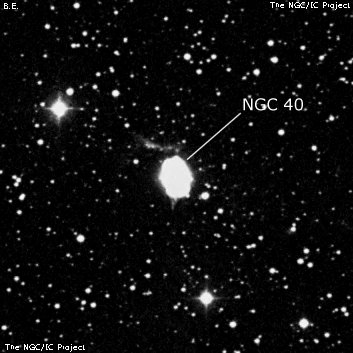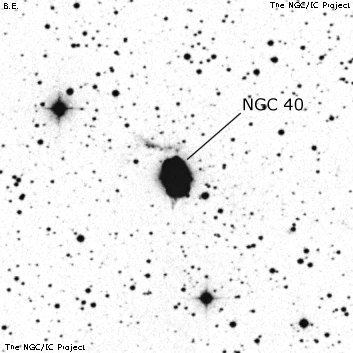NGC/IC Project Restoration Effort
(This is a very very beta version)
NGC40


Basic Information
Location and Magnitude
Right Ascension: 0:13:1.0
Declination: +72:31:21
Constellation: CEP
Visual Magnitude: 12.3
Historic Information
Discoverer: Herschel W.
Year of discovery: 1788
Discovery aperture: 18.7
Observational
Summary description: F, vS, R, vsmbM, * 12 sp
Sub-type: PN
Steve's Notes
=====
NGC 40
48" (10/23/14): this showpiece, annular planetary was viewed unfiltered (low-excitation) at 488x and 813x and a remarkable amount of detail was visible. The main section of NGC 40 is nearly round and 42" in diameter but outer extensions on the north and south ends increase the dimensions to roughly 60"x48" SSW-NNE. The darker interior surrounding the blazing mag 11.5 central star has a very uneven surface brightness and is slightly darker to the southwest of the central star.
The irregular rim in much brighter along fairly narrow N-S strips on the west and east side. The western rim is the brighter one and somewhat patchy with a slightly darker notch to the south of its center. At its north end is a small, faint extension. The eastern rim is more uniform in brightness, but a very faint, thin outer loop curls north and west at its north end! A small, detached, elongated patch floats near the north edge, but slightly south of the tip of the outer loop to its east. A very faint star or stellar knot is involved in this patch.
The rim is very weak on the south side and an easy star is at the southwest end. A very small, faint detached glow was easily visible at the southern extremity [32" SSW of the central star] of NGC 40. This patch forms the eastern vertex of a small triangle with a star ~10" NW (noted earlier) and a fainter star 10" SE.
17.5" (12/30/99): at 100x appeared (unfiltered) as a slightly elongated, moderately bright disc surrounding a bright mag 11.5 central star. A slightly fainter mag 12 star lies 1.0' SW. This is a low excitation PN with an OIII/H-beta ratio of just 0.4 and at 100x there was a noticeable enhancement using the H-beta filter while it dimmed with an OIII filter. At 220x, a star was intermittently visible at the SW edge and the PN was slightly elongated SSW-NNE. The best filter response with this power was using the UHC. The surface brightness appeared irregular -- darker around the central star and slightly brighter along the west and east side of the rim. At 280x, the faint star I noted earlier was barely off the SW edge and the PN was weakly annular with a brighter rim along the west and east side and a darker center. The SW and NE ends of the halo were clearly weaker, though. 380x provided a nice view with subtle irregularities in the interior.
17.5" (11/1/86): bright, moderately large, round. Contains a prominent mag 11.5 central star surrounded by a fairly bright halo.
13" (12/7/85): at 166x, bright central star visible centered within a fairly small prominent disc.
13" (10/12/85): moderately large, bright central star surrounded by a moderately bright halo at 166x-214x using a UHC filter.
8": the bright central star is surrounded by an easy halo.



